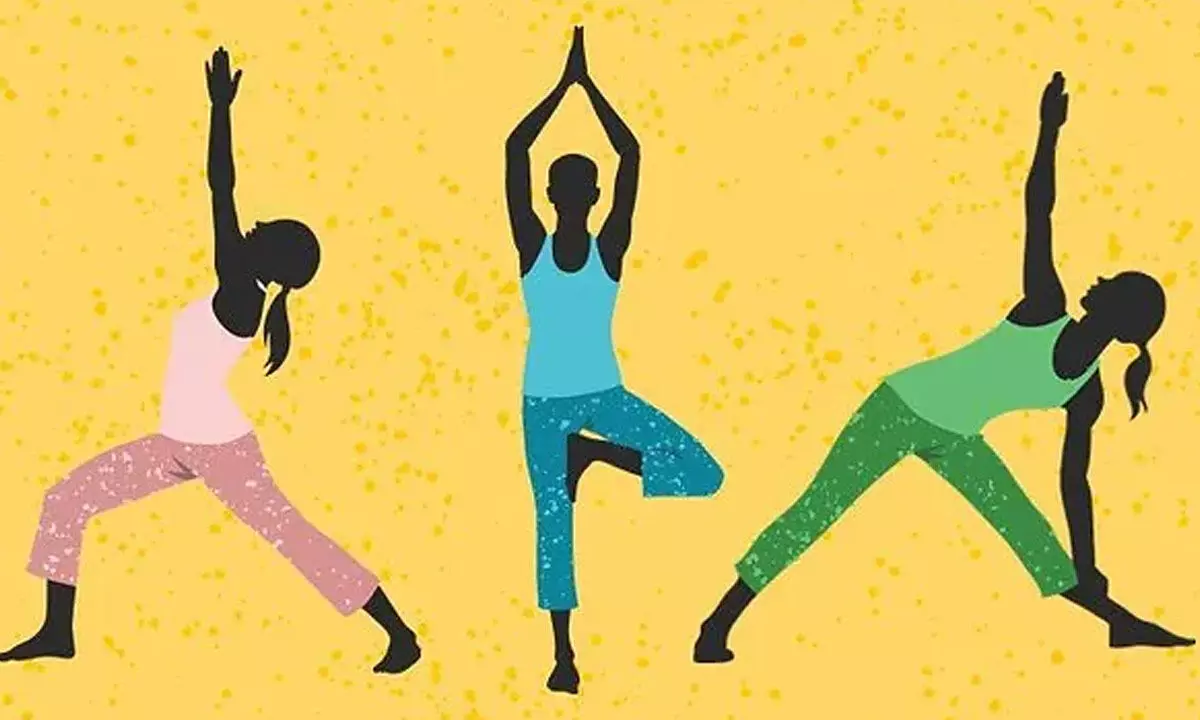Live
- They always want me to win, and now I feel lucky to have been offered a story like ‘Zebra’: Satyadev Kancharana
- ‘Democracy first, humanity first’: PM Modi in Guyana's parliament on two countries' similarities
- PKL Season 11: Telugu Titans register third straight win to top standings
- Is Pollution Contributing to Your COPD?
- NASA Unveils Underwater Robots for Exploring Jupiter's Moons
- Additional Central forces arrive in violence-hit Manipur
- AR Rahman and Saira Banu’s Divorce: Legal Insights into Common Issues in Bollywood Marriages
- 82.7 pc work completed in HPCL Rajasthan Refinery area: official
- Curfew relaxation extended in 5 Manipur districts on Friday
- Tab scam prompts Bengal govt to adopt caution over fund disbursement
Just In
Yoga for Joint Pain Relief: Embracing Wellness Through Movement


As the seasons shift, many individuals find themselves grappling with increased joint pain and stiffness, particularly during damp, cold, or rainy weather
As the seasons shift, many individuals find themselves grappling with increased joint pain and stiffness, particularly during damp, cold, or rainy weather. The discomfort often stems from changes in barometric pressure and temperature, affecting joint fluid viscosity and tissue expansion. While these mechanisms aren't fully understood, one thing remains clear: managing joint pain requires a thoughtful approach that encompasses both physical activity and mindfulness.
In recent years, yoga has emerged as a gentle yet effective practice for alleviating joint pain associated with weather sensitivity. Unlike high-impact exercises that may exacerbate discomfort, yoga offers a holistic method that combines controlled movements, strength-building poses, flexibility exercises, and stress-relieving techniques. Here’s how yoga can help you find relief and maintain joint health throughout the changing seasons.
Gentle Movement and Circulation
One of the core principles of yoga is its emphasis on gentle, controlled movement. When joints feel stiff and achy, the instinct might be to avoid motion altogether. However, this can worsen the problem by reducing circulation and allowing joints to become even stiffer. Yoga encourages practitioners to move slowly and mindfully through a range of motions, which helps:
• Increase blood flow to affected areas, delivering essential oxygen and nutrients.
• Promote synovial fluid circulation within the joints, enhancing lubrication and joint mobility.
• Gently stretch surrounding muscles and connective tissues, reducing tension and stiffness.
Beginners often benefit from poses like Cat-Cow, gentle Sun Salutations, and slow joint rotations, which promote mobility without stressing sensitive joints.
Strengthening Supporting Muscles
While yoga may not involve heavy lifting or high-impact movements, it plays a crucial role in strengthening the muscles that support and stabilize joints. This is essential for reducing strain on joints and improving overall function. Poses focused on building strength include:
• Plank and its variations for core and shoulder stability.
• Warrior poses for strengthening legs and hips.
• Chair pose for enhancing knee and ankle strength.
By developing stronger supporting muscles, individuals can better manage joint stress during daily activities and changes in weather conditions.
Improving Flexibility and Range of Motion
Flexibility is often a key concern for those experiencing joint stiffness, particularly in damp or cold weather. Yoga excels in improving flexibility through a combination of static holds and dynamic movements. These practices help:
• Lengthen muscles and fascia surrounding joints, enhancing range of motion.
• Reduce adhesions in connective tissues, promoting smoother joint movement.
• Enhance overall body awareness and proprioception, which aids in better joint control.
Poses such as Forward Folds, Pigeon pose, and gentle twists target areas prone to weather-related stiffness, such as the lower back, hips, and shoulders.
Stress Reduction and Pain Management
The mind-body connection in yoga is instrumental in managing joint pain. Chronic pain often leads to increased stress and tension, exacerbating physical symptoms. Yoga's focus on breathwork, meditation, and mindfulness helps:
• Reduce overall stress levels and muscle tension, providing relief from pain.
• Improve pain tolerance and management through relaxation techniques.
• Promote a positive outlook on coping with chronic conditions, fostering resilience.
Incorporating relaxation practices like Savasana (Corpse pose) and guided body scans can be particularly beneficial for individuals experiencing weather-related joint discomfort.
Consistency and Long-Term Benefits
While yoga can offer immediate relief from weather-related joint pain, its true power lies in consistent practice. Regular yoga sessions contribute to:
• Improved overall joint health and function.
• Enhanced body awareness and posture correction.
• Increased resilience to weather-related symptoms over time.
It's important to approach yoga as a holistic tool for managing joint health, seeking guidance from healthcare providers, especially for those with pre-existing joint conditions. With proper instruction and regular practice, yoga becomes a powerful ally in maintaining joint comfort and mobility across varying weather conditions.
In conclusion, yoga provides a comprehensive approach to alleviating joint pain and stiffness exacerbated by weather changes. Through gentle movement, strength-building exercises, flexibility routines, and stress management techniques, yoga not only offers immediate relief but also fosters long-term joint health and overall well-being. Whether you're looking to ease discomfort during monsoon season or enhance joint resilience year-round, integrating yoga into your daily routine can significantly contribute to your health and quality of life.

© 2024 Hyderabad Media House Limited/The Hans India. All rights reserved. Powered by hocalwire.com






